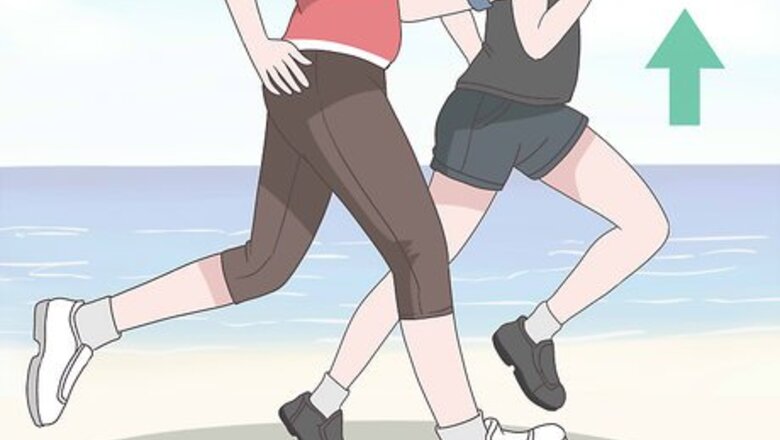
views
Working on Your Exercise Routine
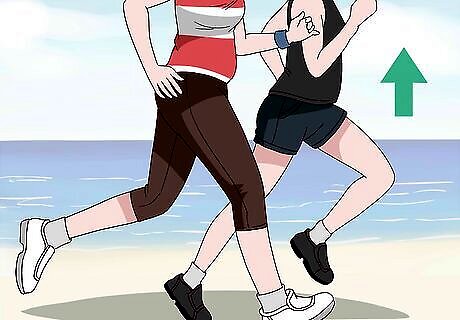
Increase how much you exercise. The standard advice for how much you should exercise in a week is 30 minutes most days of the week. If you're not getting in much exercise at all, work up to this amount. If you're already doing this and still not losing weight, you may need to increase what you're doing. Because your metabolism is slower, you may need to do more to see the same results. You can do any exercise you enjoy, from swimming and jogging to bicycling or playing basketball or tennis. Walking is also good! If your workouts are more intense, you can get away with less. For instance, if you exercise hard for 20 minutes and are breathing heavy through most of it, you may get away with 3 sessions a week. Grab a buddy to make it easier to get moving! They'll help hold you accountable.
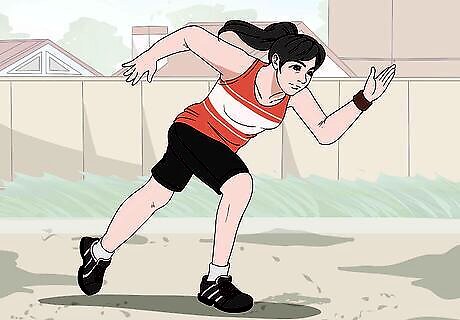
Add high-intensity interval training (HIIT) to your workouts. As you age, it can be difficult to take off weight because your metabolism slows. Adding different styles of training, such as HIIT, to your workout can help combat that. HIIT just means alternating between going all out for a short period and then doing a slower exercise or resting for a short period. This can help you burn more fat more quickly, and it can also kick up your metabolism for the rest of the day. Aim for a 1:2 ratio. That is, work hard for, say, 30 seconds, then rest or do a slower exercise for 60 seconds. For instance, try running as hard as you can for 30 seconds, then slow down and walk for 60 seconds. Run again for 30 seconds and rest again for 60, working for 20-45 minutes. You can move up to a 1:1 ratio if you're more in shape. You can do this with almost any exercise, including running, biking, and swimming.
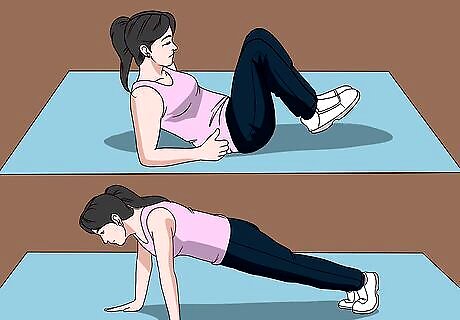
Make resistance training a part of your workout twice a week. Aim for 1-hour sessions each time. As you get older, you tend to lose muscle over time, which slows down your metabolism. Actively working on building muscle will help you keep that metabolism up and lose weight, including around your belly. To help tone your belly, try core exercises that specifically work this area, such as crunches, abdominal presses, and planking. Anything that builds muscle will help you lose weight, including squats, lunges, bench presses, pushups, and shoulder presses. You can even just start out using canned goods or water bottles for weights.
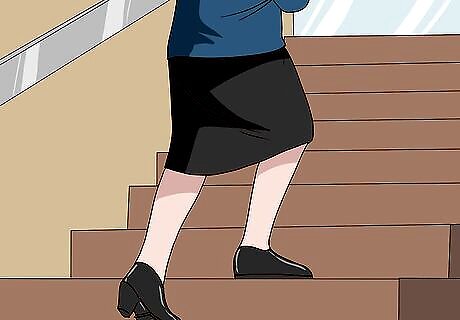
Fit in more movement when you can. You don't have to hit the gym to get in more exercise. Just add a bit more here and there to your day. For example, take the stairs instead of the elevator or escalator and park as far out as you can in the parking lot when you stop at the store. You can also use your breaks to walk around the building at work or take a lap around the office when you go to the bathroom. Alternatively, go to the bathroom on a different floor and take the stairs up. Instead of taking the subway the whole way to work, get off a little early and walk the rest of the way.
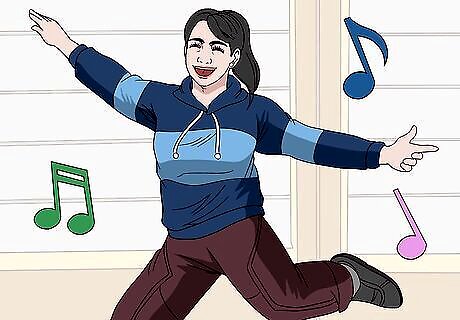
Pick fun activities that get you moving outside of the gym. The more you enjoy the exercise you choose, the more likely you are to do it! You can do things like joining a softball or bowling league or getting involved with a community garden. Play with your pets or your kids for a little while each day; they're sure to get you moving. You can also put on music and dance around while you do housework or groove while you're cooking. Set up a homemade slip-and-slide in the backyard with your kids or have a water-gun or water balloon fight in the summer.
Changing up Your Diet
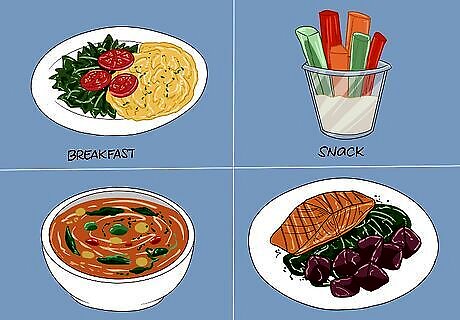
Make half your plate fruits and vegetables. When you sit down to a meal, if half your plate is filled up with fruits and vegetables, you'll likely eat fewer calories. Plus, you'll stay fuller longer due to the high fiber in these foods. Eat a wide variety of colors to get all your nutrients in! For instance, at breakfast, try spinach, tomato, and mushroom in your egg scramble or avocado and radishes on toast. As a snack, try hummus with fresh raw vegetables. At lunch, eat a vegetable-based soup, fill up a wrap with a little sliced turkey and tons of veggies, or try a brown rice bowl topped with roasted broccoli, cauliflower, and mushrooms. For dinner, opt for fish paired with sauteed spinach and roasted beets, try an Alfredo sauce made from cauliflower and topped with broccoli and mushrooms, or eat a large salad filled with lots of vegetables.
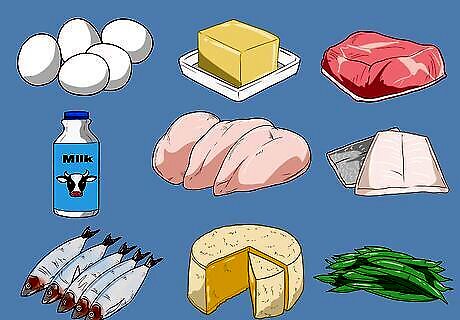
Opt for lean proteins throughout the day. Lean proteins include foods like boneless skinless chicken, eggs, lean pork (such as tenderloin), fish, beans, lentils, tofu, and 90% lean ground beef. Low-fat dairy can also be a good source of protein. Aim to eat at least some protein with every meal so you stay satisfied. When eating meat, aim for a serving that's about the size of a deck of cards.
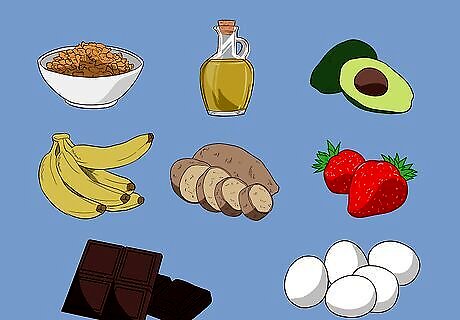
Take about 200 calories out of your diet per day. Because your metabolism slows down after menopause, you need to lower your caloric intake to help you lose weight. If you're not sure how many calories you're currently eating, try tracking your food in a journal or with a food app. That way, you can see where you can cut back. Always measure out your foods to see how much you're eating! In general, people tend to underestimate how much they eat. Cutting out 200 calories could be as simple as swapping a flavored latte with sugar for a black coffee. Try choosing air-popped popcorn over flavored chips or a handful of strawberries for dessert over ice cream. Just simple swaps can help you lower your calories.
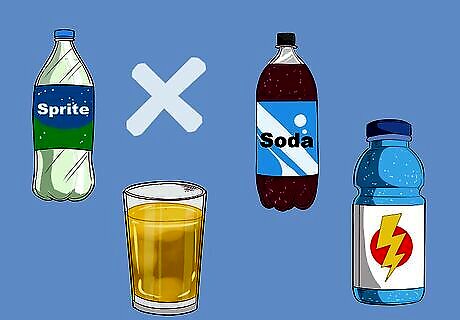
Lower your intake of sugary beverages and foods. While you don't need to skip out on these foods altogether, they can add a lot of unnecessary calories to your diet. Sugary drinks, in particular, provide a lot of empty calories. Try to avoid sodas, sports drinks, and even juices, as they all add up quickly. Instead, drink unsweetened tea or coffee, sparkling water with fruit in it, or plain water. If you want something sweet after dinner, try a piece of fruit or a small piece of dark chocolate.

Take a smaller portion at meals to begin with. Instead of taking 2 large scoops of pasta, try 1 1/2. Instead of going for 2 pork chops, opt for 1. Just take a little bit less than you normally would. Then, after eating and resting a few minutes, you can enjoy more fruits and vegetables if you still feel hungry. It can help to use smaller plates. That way, even if you fill it up, you won't be taking as much as you would if you used a larger plate. If you're eating out, ask for a box when they bring your meal out. Box up half to take home and just eat half for your meal.
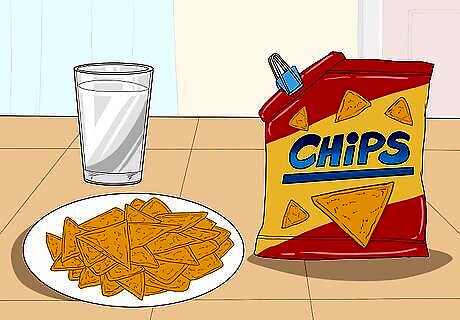
Portion out foods every time you eat. If you eat chips out of a bag, you can lose perspective about how much you're eating. Instead, dish out those chips, either counting or measuring them to get 1 serving size. Then, put the package away so you won't get more out. Also, make sure you check the package so you know what a serving size is!
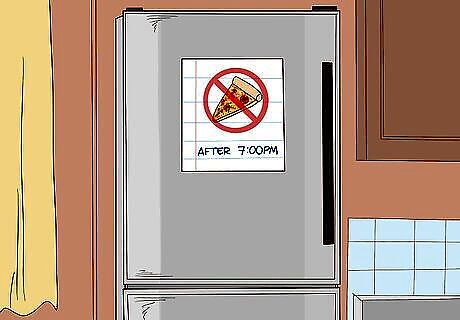
Avoid snacking after 7 p.m. to create a fasting window. By shutting down the kitchen at this time, you are essentially doing a form of intermittent fasting, meaning fasting for part of the day or week. If you stop eating at 7 p.m. and don't eat again until 7 a.m., that's 12 hours where you're not eating, and it cuts back on your calories. Plus, some studies have shown this method of dieting can help you lose abdominal fat in particular. It doesn't have to be 7 p.m. if you keep a non-traditional schedule. Just try to create a window of 12 hours in a day when you don't eat.
Making Healthy Lifestyle Choices
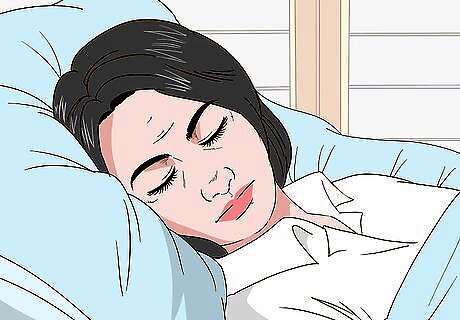
Get 7-8 hours of sleep each night. Sleeping is essential to your health, and if you're not getting enough, that could be one reason you're not losing weight. If you have trouble going to bed on time, try setting an alarm to remind you an hour before you need to be asleep. If you're having more trouble getting to sleep as you get older, ask your doctor about a sleep study. You may have a condition like sleep apnea contributing to your insomnia. When your alarm for bed goes off, turn off all your electronics and start winding down for bed. If your bedroom isn't conducive to sleeping, make some changes. Shut out all the light you can with curtains and even shove a towel under the door if you need to. Turn off noise in the house or try a white noise machine to drown it out. If you have pets, put them out of your bedroom so they don't disturb your rest. Try turning the AC down, too, as you typically sleep better in a colder room.

Drink enough water to stay hydrated and suppress your appetite. As you age, you're not as tuned in to your body's need for water as you were when you were younger. Therefore, it's important to be vigilant about getting enough water. If you're working out a lot, you'll likely need a bit more. Try drinking water before meals to help slow down your appetite. To get more water in, try drinking flavored, unsweetened sparkling water or buy a large water bottle that holds what you need to drink for the day.

Stop smoking to help you lose belly fat. As you probably know, smoking causes a host of health problems. However, you may not know that it can make you gain weight around your belly. If you've been looking for a reason to quit, now may be the time to do it. Talk to your doctor about quitting, and they'll be able to advise you about things to help you quit, such as nicotine pills or patches. Join a group for people trying to quit, as they'll be able to help you learn coping techniques for your triggers. Replace smoking with other activities. For example, try drinking a cup of black tea in the morning instead of smoking.

Find positive ways to deal with mood swings instead of eating. If you're an emotional eater, you're certainly not alone. Hormone changes can cause your emotions to be more unstable as you move into menopause, making this problem worse. In fact, some people suffer from depression when going through this stage of life. If you find mood swings are getting you down, try other, more positive activities to deal with them, such as going on walks, journaling, or trying out new hobbies. However, if you are suffering from depression, don't be afraid to talk to your doctor or therapist about it. They can help talk you through it or get you on a medication that may help.


















Comments
0 comment